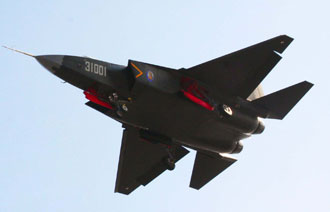China’s bold expansion of its air defense identification zone to include swatches of airspace above the disputed Senkakus, as well as over the shelf extending out of S. Korea’s Jeju Islands, have dramatically driven up the possibility of air clashes.
On Saturday China in effect declared the right to shoot down unidentified foreign aircraft that fly near the Senkakus (Diaoyudao) as well as over a swatch of water surrounding S. Korea’s southwestern resort isle of Jeju. That statement was immediately countered statements from both Japan and S. Korea.
The possibility of air clashes with S. Korea are remote given an absence of recent territorial tensions, but the Chinese declaration is almost certain to create military standoffs with Japan which already exercises de facto control over the islets.
On Sunday Tokyo released a strong statement refusing to recognize China’s claim. Japan’s foreign minister Fumio Kishida called the Chinese declaration a dangerous escalation of tensions that can lead to a shooting war.
“It was a one-sided action and cannot be allowed,” Kishida said, adding that it could “trigger unpredictable events.”
Kishida’s statement produced an immediate rejoinder from China’s Foreign Ministry.
“The Japanese side’s irresponsible comments about China’s demarcation of an East China Sea air defense identification zone are totally wrong,” said a statement on its website.
The US, which also now faces the danger of being drawn into a potential conflict between China and its biggest Asian ally, released a statement Saturday in which Defense Secretary Chuck Hagel called China’s declaration “a destabilizing attempt to alter the status quo in the region.”
Significantly, he added that the US would stand by its security treaty obligations which obliges the US to come to Japan’s aid if it were attacked. Last year the US clarified that it would not defend Japan if it triggers a conflict with China by trying to change the status quo of the Senkakus. This has created a degree of ambiguity as to the circumstances under which the US would join in a military clash between the two leading Asian powers.
Beijing has repeatedly insisted that the US have no role in a conflict between China and Japan over the Senkakus. It sent a complaint to US Ambassador Gary Locke about remarks and Secretary of State John Kerry and Defense Secretary Chuck Hagel warning that China is escalating tensions by trying to change the status quo.
Saturday saw a situation that is likely to become more fraught due to China’s new declaration. Two Chinese surveillance planes approaching the disputed islets were turned back by F-15 fighters scrambled by Japan.
“This is seriously impeding freedom of flight, and could very easily trigger a safety accident or unexpected incident,” said a Chinese spokesman about the incident.
China’s new declaration raises the possibility and even the likelihood that future encounters may not end so peacefully.
Last Thursday a Chinese coast guard officers boarded a Chinese fishing boat near the islands. A Japanese coast guard vessel hailed the Chinese coast guard ship and was told that it was monitoring fishing in Chinese waters.
The latest Chinese declaration of an expanded air defense zone appears to be an effort by China gradually to place itself on the same footing as Japan which already maintains an air defense zone around the islets. In the process, Beijing will learn whether its recent naval buildup will induce Japan to back off its claim over the islets.


